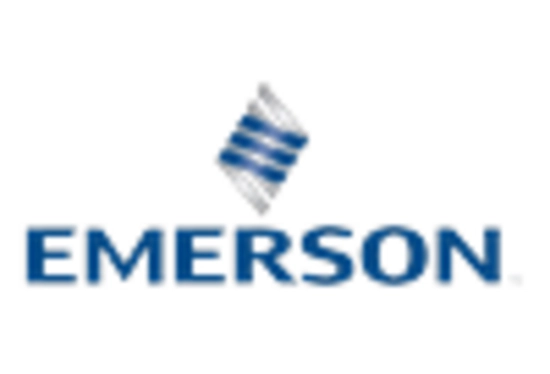-
EXECUTIVE SUMMARY
-
MARKET INTRODUCTION
-
Definition
-
Scope of the Study
- Research Objective
- Assumptions
- Limitations
-
RESEARCH METHODOLOGY
-
Overview
-
Data Mining
-
Secondary Research
-
Primary Research
- Primary Interviews and Information Gathering Process
- Breakdown of Primary Respondents
-
Forecasting Modality
-
Market Size Estimation
- Bottom-Up Approach
- Top-Down Approach
-
Data Triangulation
-
Validation
-
MARKET DYNAMICS
-
Overview
-
Drivers
-
Restraints
-
Opportunities
-
MARKET FACTOR ANALYSIS
-
Value Chain Analysis
-
Porter’s Five Forces Analysis
- Bargaining Power of Suppliers
- Bargaining Power of Buyers
- Threat of New Entrants
- Threat of Substitutes
- Intensity of Rivalry
-
COVID-19 Impact Analysis
- Market Impact Analysis
- Regional Impact
- Opportunity and Threat Analysis
-
GLOBAL INDUSTRIAL COMMUNICATION MARKET, BY OFFERINGS
-
Overview
-
Software
-
Hardware
-
Services
-
GLOBAL INDUSTRIAL COMMUNICATION MARKET, BY COMMUNICATION PROTOCOL
-
Overview
-
Industrial Ethernet
-
Fieldbus
-
Wireless
-
GLOBAL INDUSTRIAL COMMUNICATION MARKET, BY END USER
-
Overview
-
Automotive and Transportation
-
Aerospace & Defense
-
Food & Beverages
-
Electrical & Electronics
-
Industrial Manufacturing
-
Others
-
GLOBAL INDUSTRIAL COMMUNICATION MARKET, BY REGION
-
Overview
-
North America
- U.S.
- Canada
-
Europe
- Germany
- France
- U.K
- Italy
- Spain
- Rest of Europe
-
Asia-Pacific
- China
- India
- Japan
- South Korea
- Australia
- Rest of Asia-Pacific
-
Rest of the World
- Middle East
- Africa
- Latin America
-
COMPETITIVE LANDSCAPE
-
Overview
-
Competitive Analysis
-
Market Share Analysis
-
Major Growth Strategy in the Global Industrial Communication Market,
-
Competitive Benchmarking
-
Leading Players in Terms of Number of Developments in the Global Industrial Communication Market,
-
Key developments and Growth Strategies
- New Product Launch/Application Deployment
- Merger & Acquisitions
- Joint Ventures
-
Major Players Financial Matrix
- Sales & Operating Income, 2022
- Major Players R&D Expenditure. 2022
-
COMPANY PROFILES
-
ABB Ltd.
- Company Overview
- Financial Overview
- Products Offered
- Key Developments
- SWOT Analysis
- Key Strategies
-
Advantech Co. Ltd.
- Company Overview
- Financial Overview
- Products Offered
- Key Developments
- SWOT Analysis
- Key Strategies
-
Cisco Systems Inc.
- Company Overview
- Financial Overview
- Products Offered
- Key Developments
- SWOT Analysis
- Key Strategies
-
Emerson Electric Co.
- Company Overview
- Financial Overview
- Products Offered
- Key Developments
- SWOT Analysis
- Key Strategies
-
General Electric Co.
- Company Overview
- Financial Overview
- Products Offered
- Key Developments
- SWOT Analysis
- Key Strategies
-
NATIONAL INSTRUMENTS CORP.
- Company Overview
- Financial Overview
- Products Offered
- Key Developments
- SWOT Analysis
- Key Strategies
-
Rockwell Automation Inc.
- Company Overview
- Financial Overview
- Products Offered
- Key Developments
- SWOT Analysis
- Key Strategies
-
Schneider Electric SE
- Company Overview
- Financial Overview
- Products Offered
- Key Developments
- SWOT Analysis
- Key Strategies
-
Siemens AG
- Company Overview
- Financial Overview
- Products Offered
- Key Developments
- SWOT Analysis
- Key Strategies
-
Texas Instruments Inc
- Company Overview
- Financial Overview
- Products Offered
- Key Developments
- SWOT Analysis
- Key Strategies
-
APPENDIX
-
References
-
Related Reports
-
-
LIST OF TABLES
-
GLOBAL INDUSTRIAL COMMUNICATION MARKET, SYNOPSIS, 2025-2034
-
GLOBAL INDUSTRIAL COMMUNICATION MARKET, ESTIMATES & FORECAST, 2025-2034 (USD BILLION)
-
GLOBAL INDUSTRIAL COMMUNICATION MARKET, BY OFFERINGS, 2025-2034 (USD BILLION)
-
GLOBAL INDUSTRIAL COMMUNICATION MARKET, BY COMMUNICATION PROTOCOL, 2025-2034 (USD BILLION)
-
GLOBAL INDUSTRIAL COMMUNICATION MARKET, BY END USER, 2025-2034 (USD BILLION)
-
NORTH AMERICA INDUSTRIAL COMMUNICATION MARKET, BY OFFERINGS, 2025-2034 (USD BILLION)
-
NORTH AMERICA INDUSTRIAL COMMUNICATION MARKET, BY COMMUNICATION PROTOCOL, 2025-2034 (USD BILLION)
-
NORTH AMERICA INDUSTRIAL COMMUNICATION MARKET, BY END USER, 2025-2034 (USD BILLION)
-
NORTH AMERICA INDUSTRIAL COMMUNICATION MARKET, BY COUNTRY, 2025-2034 (USD BILLION)
-
U.S. INDUSTRIAL COMMUNICATION MARKET, BY OFFERINGS, 2025-2034 (USD BILLION)
-
U.S. INDUSTRIAL COMMUNICATION MARKET, BY COMMUNICATION PROTOCOL, 2025-2034 (USD BILLION)
-
U.S. INDUSTRIAL COMMUNICATION MARKET, BY END USER, 2025-2034 (USD BILLION)
-
CANADA INDUSTRIAL COMMUNICATION MARKET, BY OFFERINGS, 2025-2034 (USD BILLION)
-
CANADA INDUSTRIAL COMMUNICATION MARKET, BY COMMUNICATION PROTOCOL, 2025-2034 (USD BILLION)
-
CANADA INDUSTRIAL COMMUNICATION MARKET, BY END USER, 2025-2034 (USD BILLION)
-
EUROPE INDUSTRIAL COMMUNICATION MARKET, BY OFFERINGS, 2025-2034 (USD BILLION)
-
EUROPE INDUSTRIAL COMMUNICATION MARKET, BY COMMUNICATION PROTOCOL, 2025-2034 (USD BILLION)
-
EUROPE INDUSTRIAL COMMUNICATION MARKET, BY END USER, 2025-2034 (USD BILLION)
-
EUROPE INDUSTRIAL COMMUNICATION MARKET, BY COUNTRY, 2025-2034 (USD BILLION)
-
GERMANY INDUSTRIAL COMMUNICATION MARKET, BY OFFERINGS, 2025-2034 (USD BILLION)
-
GERMANY INDUSTRIAL COMMUNICATION MARKET, BY COMMUNICATION PROTOCOL, 2025-2034 (USD BILLION)
-
GERMANY INDUSTRIAL COMMUNICATION MARKET, BY END USER, 2025-2034 (USD BILLION)
-
FRANCE INDUSTRIAL COMMUNICATION MARKET, BY OFFERINGS, 2025-2034 (USD BILLION)
-
FRANCE INDUSTRIAL COMMUNICATION MARKET, BY COMMUNICATION PROTOCOL, 2025-2034 (USD BILLION)
-
FRANCE INDUSTRIAL COMMUNICATION MARKET, BY END USER, 2025-2034 (USD BILLION)
-
ITALY INDUSTRIAL COMMUNICATION MARKET, BY OFFERINGS, 2025-2034 (USD BILLION)
-
ITALY INDUSTRIAL COMMUNICATION MARKET, BY COMMUNICATION PROTOCOL, 2025-2034 (USD BILLION)
-
ITALY INDUSTRIAL COMMUNICATION MARKET, BY END USER, 2025-2034 (USD BILLION)
-
SPAIN INDUSTRIAL COMMUNICATION MARKET, BY OFFERINGS, 2025-2034 (USD BILLION)
-
SPAIN INDUSTRIAL COMMUNICATION MARKET, BY COMMUNICATION PROTOCOL, 2025-2034 (USD BILLION)
-
SPAIN INDUSTRIAL COMMUNICATION MARKET, BY END USER, 2025-2034 (USD BILLION)
-
U.K INDUSTRIAL COMMUNICATION MARKET, BY OFFERINGS, 2025-2034 (USD BILLION)
-
U.K INDUSTRIAL COMMUNICATION MARKET, BY COMMUNICATION PROTOCOL, 2025-2034 (USD BILLION)
-
U.K INDUSTRIAL COMMUNICATION MARKET, BY END USER, 2025-2034 (USD BILLION)
-
REST OF EUROPE INDUSTRIAL COMMUNICATION MARKET, BY OFFERINGS, 2025-2034 (USD BILLION)
-
REST OF EUROPE INDUSTRIAL COMMUNICATION MARKET, BY COMMUNICATION PROTOCOL, 2025-2034 (USD BILLION)
-
REST OF EUROPE INDUSTRIAL COMMUNICATION MARKET, BY END USER, 2025-2034 (USD BILLION)
-
ASIA PACIFIC INDUSTRIAL COMMUNICATION MARKET, BY OFFERINGS, 2025-2034 (USD BILLION)
-
ASIA PACIFIC INDUSTRIAL COMMUNICATION MARKET, BY COMMUNICATION PROTOCOL, 2025-2034 (USD BILLION)
-
ASIA PACIFIC INDUSTRIAL COMMUNICATION MARKET, BY END USER, 2025-2034 (USD BILLION)
-
ASIA PACIFIC INDUSTRIAL COMMUNICATION MARKET, BY COUNTRY, 2025-2034 (USD BILLION)
-
JAPAN INDUSTRIAL COMMUNICATION MARKET, BY OFFERINGS, 2025-2034 (USD BILLION)
-
JAPAN INDUSTRIAL COMMUNICATION MARKET, BY COMMUNICATION PROTOCOL, 2025-2034 (USD BILLION)
-
JAPAN INDUSTRIAL COMMUNICATION MARKET, BY END USER, 2025-2034 (USD BILLION)
-
CHINA INDUSTRIAL COMMUNICATION MARKET, BY OFFERINGS, 2025-2034 (USD BILLION)
-
CHINA INDUSTRIAL COMMUNICATION MARKET, BY COMMUNICATION PROTOCOL, 2025-2034 (USD BILLION)
-
CHINA INDUSTRIAL COMMUNICATION MARKET, BY END USER, 2025-2034 (USD BILLION)
-
INDIA INDUSTRIAL COMMUNICATION MARKET, BY OFFERINGS, 2025-2034 (USD BILLION)
-
INDIA INDUSTRIAL COMMUNICATION MARKET, BY COMMUNICATION PROTOCOL, 2025-2034 (USD BILLION)
-
INDIA INDUSTRIAL COMMUNICATION MARKET, BY END USER, 2025-2034 (USD BILLION)
-
AUSTRALIA INDUSTRIAL COMMUNICATION MARKET, BY OFFERINGS, 2025-2034 (USD BILLION)
-
AUSTRALIA INDUSTRIAL COMMUNICATION MARKET, BY COMMUNICATION PROTOCOL, 2025-2034 (USD BILLION)
-
AUSTRALIA INDUSTRIAL COMMUNICATION MARKET, BY END USER, 2025-2034 (USD BILLION)
-
SOUTH KOREA INDUSTRIAL COMMUNICATION MARKET, BY OFFERINGS, 2025-2034 (USD BILLION)
-
SOUTH KOREA INDUSTRIAL COMMUNICATION MARKET, BY COMMUNICATION PROTOCOL, 2025-2034 (USD BILLION)
-
SOUTH KOREA INDUSTRIAL COMMUNICATION MARKET, BY END USER, 2025-2034 (USD BILLION)
-
REST OF ASIA-PACIFIC INDUSTRIAL COMMUNICATION MARKET, BY OFFERINGS, 2025-2034 (USD BILLION)
-
REST OF ASIA-PACIFIC INDUSTRIAL COMMUNICATION MARKET, BY COMMUNICATION PROTOCOL, 2025-2034 (USD BILLION)
-
REST OF ASIA-PACIFIC INDUSTRIAL COMMUNICATION MARKET, BY END USER, 2025-2034 (USD BILLION)
-
REST OF WORLD INDUSTRIAL COMMUNICATION MARKET, BY OFFERINGS, 2025-2034 (USD BILLION)
-
REST OF WORLD INDUSTRIAL COMMUNICATION MARKET, BY COMMUNICATION PROTOCOL, 2025-2034 (USD BILLION)
-
REST OF WORLD INDUSTRIAL COMMUNICATION MARKET, BY END USER, 2025-2034 (USD BILLION)
-
REST OF WORLD INDUSTRIAL COMMUNICATION MARKET, BY COUNTRY, 2025-2034 (USD BILLION)
-
MIDDLE EAST INDUSTRIAL COMMUNICATION MARKET, BY OFFERINGS, 2025-2034 (USD BILLION)
-
MIDDLE EAST INDUSTRIAL COMMUNICATION MARKET, BY COMMUNICATION PROTOCOL, 2025-2034 (USD BILLION)
-
MIDDLE EAST INDUSTRIAL COMMUNICATION MARKET, BY END USER, 2025-2034 (USD BILLION)
-
AFRICA INDUSTRIAL COMMUNICATION MARKET, BY OFFERINGS, 2025-2034 (USD BILLION)
-
AFRICA INDUSTRIAL COMMUNICATION MARKET, BY COMMUNICATION PROTOCOL, 2025-2034 (USD BILLION)
-
AFRICA INDUSTRIAL COMMUNICATION MARKET, BY END USER, 2025-2034 (USD BILLION)
-
LATIN AMERICA INDUSTRIAL COMMUNICATION MARKET, BY OFFERINGS, 2025-2034 (USD BILLION)
-
LATIN AMERICA INDUSTRIAL COMMUNICATION MARKET, BY COMMUNICATION PROTOCOL, 2025-2034 (USD BILLION)
-
LATIN AMERICA INDUSTRIAL COMMUNICATION MARKET, BY END USER, 2025-2034 (USD BILLION)
-
LIST OF FIGURES
-
RESEARCH PROCESS
-
MARKET STRUCTURE FOR THE GLOBAL INDUSTRIAL COMMUNICATION MARKET
-
MARKET DYNAMICS FOR THE GLOBAL INDUSTRIAL COMMUNICATION MARKET
-
GLOBAL INDUSTRIAL COMMUNICATION MARKET, SHARE (%), BY OFFERINGS, 2022
-
GLOBAL INDUSTRIAL COMMUNICATION MARKET, SHARE (%), BY COMMUNICATION PROTOCOL, 2022
-
GLOBAL INDUSTRIAL COMMUNICATION MARKET, SHARE (%), BY END USER, 2022
-
GLOBAL INDUSTRIAL COMMUNICATION MARKET, SHARE (%), BY REGION, 2022
-
NORTH AMERICA: INDUSTRIAL COMMUNICATION MARKET, SHARE (%), BY REGION, 2022
-
EUROPE: INDUSTRIAL COMMUNICATION MARKET, SHARE (%), BY REGION, 2022
-
ASIA-PACIFIC: INDUSTRIAL COMMUNICATION MARKET, SHARE (%), BY REGION, 2022
-
REST OF THE WORLD: INDUSTRIAL COMMUNICATION MARKET, SHARE (%), BY REGION, 2022
-
GLOBAL INDUSTRIAL COMMUNICATION MARKET: COMPANY SHARE ANALYSIS, 2022 (%)
-
ABB LTD.: FINANCIAL OVERVIEW SNAPSHOT
-
ABB LTD.: SWOT ANALYSIS
-
ADVANTECH CO. LTD.: FINANCIAL OVERVIEW SNAPSHOT
-
ADVANTECH CO. LTD.: SWOT ANALYSIS
-
CISCO SYSTEMS INC.: FINANCIAL OVERVIEW SNAPSHOT
-
CISCO SYSTEMS INC.: SWOT ANALYSIS
-
EMERSON ELECTRIC CO.: FINANCIAL OVERVIEW SNAPSHOT
-
EMERSON ELECTRIC CO.: SWOT ANALYSIS
-
GENERAL ELECTRIC CO..: FINANCIAL OVERVIEW SNAPSHOT
-
GENERAL ELECTRIC CO..: SWOT ANALYSIS
-
NATIONAL INSTRUMENTS CORP.: FINANCIAL OVERVIEW SNAPSHOT
-
NATIONAL INSTRUMENTS CORP.: SWOT ANALYSIS
-
ROCKWELL AUTOMATION INC.: FINANCIAL OVERVIEW SNAPSHOT
-
ROCKWELL AUTOMATION INC.: SWOT ANALYSIS
-
SCHNEIDER ELECTRIC SE: FINANCIAL OVERVIEW SNAPSHOT
-
SCHNEIDER ELECTRIC SE: SWOT ANALYSIS
-
SIEMENS AG: FINANCIAL OVERVIEW SNAPSHOT
-
SIEMENS AG: SWOT ANALYSIS
-
TEXAS INSTRUMENTS INC: FINANCIAL OVERVIEW SNAPSHOT
-
TEXAS INSTRUMENTS INC: SWOT ANALYSIS'









Leave a Comment